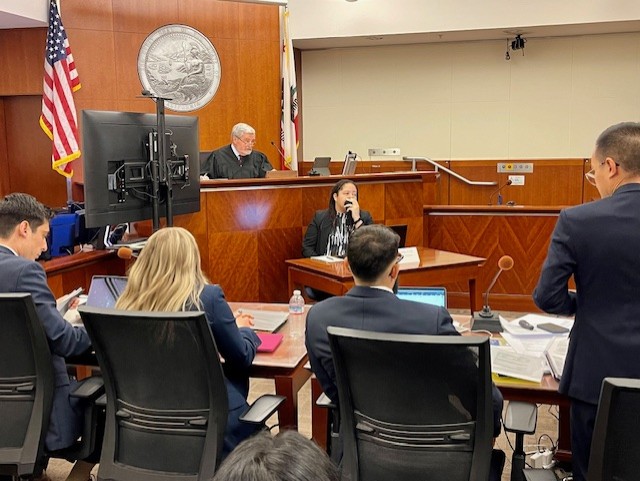Shorthand was invented by Sumerian scribes, who captured speech by writing logo-syllabic cuneiform on clay tablets with a reed stylus. Since then, shorthand methods have evolved into writing with pen on paper; steno machine; and speaking into a steno mask.
On September 27, 2022, California Governor Gavin Newsom signed Assembly Bill No. 156 (AB-156)[1] into law, allowing voice writers to take the rigorous Certified Shorthand Reporter (CSR) exam and to work in this state.
What is “Voice” Writing?
In the early 1940s, Horace Webb, a shorthand pen writer,[2] invented a method of capturing the record where stenographers repeat verbatim every word into a stenomask in a way that their voices are inaudible to participants and do not disrupt court or deposition proceedings.
AB-156 defines voice writing “… as a verbatim record of a proceeding using a closed microphone voice dictation silencer, steno mask, or similar device using oral shorthand and voice notes made by a Certified Shorthand Reporter.”
How does Voice Writing Differ from Steno Machine Writing?
There are more similarities than differences between these two methods.
Similarities
- Complete rigorous education, training, and certification requirements
- Use brief forms of complex words and phrases to shorten their writing (i.e., shorthand)
- Identify every speaker and format and punctuate transcripts on the fly
- Utilize Computer-Aided Transcription (CAT) systems to produce verbatim transcripts
- Provide realtime[3] text of proceedings instantaneously
- Adhere to the same high standards of professionalism, impartiality, confidentiality, ethics, accountability, and local, state, and federal rules, statutes, and laws.
Differences
| Steno machine writers | Voice writers |
| Write what they hear by precise finger placement of thousands of memorized shorthand word / phrase combinations and steno briefs, using technologically advanced, specialized, chorded steno machines which are connected to their CAT software | Dictate in English what they hear into specialized masks connected to two software programs. Their word / phrase combinations and voice briefs are simultaneously translated into text using advanced speech recognition such as Dragon and their CAT software |
| Learn the stenographic alphabet[4] (theory) and how to write on a steno machine keyboard beginning at zero words per minute (wpm). May spend years building speed before taking the CSR certification exam at 200 wpm. | Begin learning voice theory in English at 120-140 wpm and build speed. May reach 200 wpm and take the CSR certification exam in as little as a year because they do not need to learn a foreign language. |
Impact on Court Reporting
Since the adoption of voice writing in 2022, court reporting schools throughout California have experienced an upsurge of enrollment. Voice writing students (many of whom switched from steno machine writing) have been passing the state’s difficult Certified Shorthand Reporter (CSR) exam[5] at a high rate. As a result, voice writers have been helping to meet the demand for court reporters by filling empty seats in courtrooms throughout the state[6].
Challenges and Considerations
Although voice writers[7] have worked for over 80 years in the military, abroad, and now in 46 states[8], most California judges, lawyers, their staff, and consumers are unfamiliar with this method of capturing the legal record. Integrating voice writing into traditional court systems, deposition conference rooms, and in remote proceedings will require some adjustments to educate the legal community and public.
The National Verbatim Reporters Association (NVRA)[9] offers entry-level and advanced certification exams to both steno machine and voice writers. To earn the Certified Verbatim Reporter (CVR) certificate, examinees must pass a written knowledge exam at 70% and three 5-minute dictations with one to two speakers at a 95% accuracy transcription rate.
California’s CSR exam requires a higher standard. To earn their license, steno machine and voice writing candidates must pass two written exams (English and Professional Practices) graded on the Angoff criterion-referenced method and a 13-minute dictation exam with four speakers at a 97.5% degree of accuracy.
Conclusion
California legal professionals are assured that licensed voice writers entering the field are well equipped to provide equally high standards of performance and verbatim transcripts as traditional steno machine writers. Voice writers are poised to join their steno colleagues as cornerstones of judicial proceedings who capture and protect the record to meet the needs of consumers and help eradicate the shortage.
SAVE THE DATE: Learn more about voice writing at BASF’s Paralegal Conference on October 18, 2024!
Marilissa Cram, CVR, is a West Valley College of Court Reporting and Captioning (WVC) student and plans to take the California CSR exam in July 2024.
Ana Fatima Costa, retired California CSR, is a WVC instructor and a founding member of BASF Paralegal Section’s Executive Committee.
[1] 2022-09-28 Cal. Leg., Legislative Counsel’s Digest. Part of this law provides title protection to ensure only licensed Certified Shorthand Reporters (CSRs) are legally entitled to identify themselves as “stenographer,” “reporter,” “court reporter,” or “deposition reporter.”
[2] History: The Horace Webb Story National Verbatim Reporters Association
[3] Realtime is the instant transcription of reporters’ stenographic or voice notes into English, visible online or in person on viewers’ computers, tablets, or smartphones.
[4] Infographic of complex stenographic alphabet / keyboard by steno machine student Stefanie Bugosh
[5] California Certified Shorthand Reporter (CSR) examination requirements (steno and voice)
[6] Fact Sheet: Shortage of Certified Shorthand Reporters in California, Judicial Council of California, June 2024
[7] Photo of Jennifer Franklin, CVR, at SFTLA’s 2023 annual mock trial competition at San Francisco Superior Court, with Hon. Terence Bruiniers (Ret.) presiding. After passing the CSR, Jennifer became the court’s first voice writing official court reporter.
[8] Map of states allowing voice writing, National Verbatim Reporters Association (NVRA)
[9] National Verbatim Reporters Association (NVRA) exam certification requirements (voice and steno)


